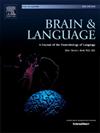Language-specific regions in the supplementary motor area: Evidence from verb generation during electrical stimulation mapping
IF 2.3
2区 心理学
Q1 AUDIOLOGY & SPEECH-LANGUAGE PATHOLOGY
引用次数: 0
Abstract
Language representation has been attributed to the perisylvian areas of the left hemisphere, with a more widely distributed network in multilingual populations. However, multilingual evidence has long obviated the involvement of regions outside classical perisylvian areas, such as the supplementary motor area (SMA). We aimed to provide novel evidence on the SMA’s role in language localization using electrical stimulation mapping (ESM) during awake brain surgery. We conducted a case-series study of 4 bilingual or multilingual patients with an expansive brain lesion near the SMA who underwent an ESM. Our results evidenced that the stimulation of the left-SMA induced language difficulties during a verb generation task, with a higher proportion of language-specific sites in the pre-SMA region. Moreover, we reported specific language sites for multiple acquired languages. Overall, our study highlighted the SMA as a language-eloquent area, likely linked to lexical decisions, while also being sensitive to different—but not necessarily all—languages of a patient.
辅助运动区的语言特异性区域:电刺激映射过程中动词生成的证据
语言表征被归因于左半球的外围区域,在多语言人群中具有更广泛的分布网络。然而,多语言证据长期以来一直排除了经典外围区域以外的区域,如辅助运动区(SMA)的参与。我们的目的是在清醒的脑外科手术中使用电刺激映射(ESM)为SMA在语言定位中的作用提供新的证据。我们对4例双语或多语患者进行了病例系列研究,这些患者在SMA附近有扩张性脑病变,并接受了ESM。我们的研究结果证明,在动词生成任务中,左侧sma的刺激导致语言困难,在sma前区域的语言特异性位点比例更高。此外,我们还报道了多种习得语言的特定语言位点。总的来说,我们的研究强调SMA是一个语言表达区域,可能与词汇决策有关,同时也对患者的不同语言敏感,但不一定是所有语言。
本文章由计算机程序翻译,如有差异,请以英文原文为准。
求助全文
约1分钟内获得全文
求助全文
来源期刊

Brain and Language
医学-神经科学
CiteScore
4.50
自引率
8.00%
发文量
82
审稿时长
20.5 weeks
期刊介绍:
An interdisciplinary journal, Brain and Language publishes articles that elucidate the complex relationships among language, brain, and behavior. The journal covers the large variety of modern techniques in cognitive neuroscience, including functional and structural brain imaging, electrophysiology, cellular and molecular neurobiology, genetics, lesion-based approaches, and computational modeling. All articles must relate to human language and be relevant to the understanding of its neurobiological and neurocognitive bases. Published articles in the journal are expected to have significant theoretical novelty and/or practical implications, and use perspectives and methods from psychology, linguistics, and neuroscience along with brain data and brain measures.
 求助内容:
求助内容: 应助结果提醒方式:
应助结果提醒方式:


